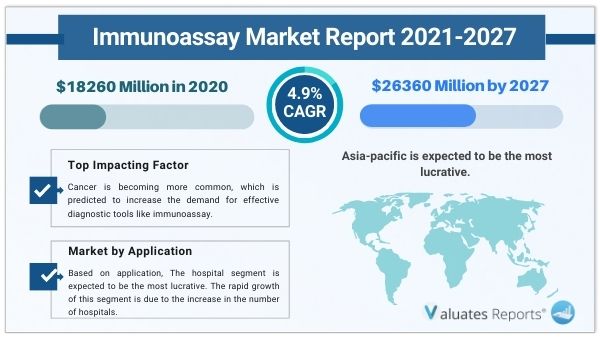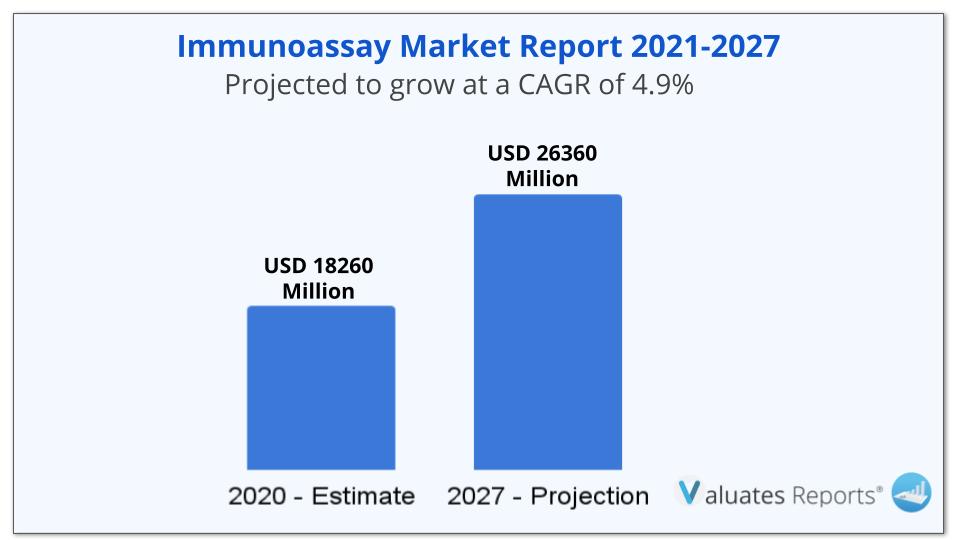
The global Immunoassay market size is projected to reach US$ 26360 million by 2027, from US$ 18260 million in 2020, at a CAGR of 4.9% during 2021-2027. Since immunoassays provide sensitive, specific results and are very simple to use, immunoassays have become increasingly popular techniques for testing biological analytes. Furthermore, some immunoassay procedures are quick, produce higher precision, and are very simple to automate, needing less hands-on involvement. As a result of these reasons, the Immunoassays market is predicted to grow.

As cancer becomes increasingly widespread, demand for effective diagnostic technologies such as immunoassay is expected to rise. This approach can be used to diagnose cancer, whether benign or malignant, and to determine oncogenesis.
Furthermore, as the frequency of COVID-19 and chronic diseases such as cardiovascular diseases, autoimmune diseases, diabetes mellitus, and nephrological diseases has increased, immunoassay techniques have become more widely used in disease diagnostics, pushing the immunoassay market.
Because of technological advancements in immunoassay techniques, the market for immunoassays is rising. ELISA is the most widely used immunoassay technology for diagnosing infectious diseases. This approach is used to test antibodies, antigens, proteins, and glycoproteins in biological materials. It aids in the diagnosis of AIDS-causing HIV, Lyme disease, pernicious anemia, Rocky Mountain spotted fever, rotavirus, squamous cell carcinoma, syphilis, toxoplasmosis, varicella-zoster virus (chickenpox and shingles), and Zika virus.

When compared to traditional testing, immunoassays have been found to provide very reliable results even with relatively few samples. These immunoassays have a detection limit of 1pg/ml, which is due to the fact that immunoassays are entirely predicated on immunologic reactions. Immunologic reactions are unique in that they can only occur when specific immunologic agents are present. This high specificity indicates that the data is accurate, allowing for superior disease detection sensitivity. This high sensitivity allows for easier detection while also eliminating the need for secondary verifications, saving time and money. As a result, the immunoassay market is being propelled forward by its high sensitivity, specificity, and cost-effectiveness.
The COVID-19 pandemic has boosted the immunoassay market even more. Immunoassay reagents and kits are in high demand around the world due to the extensive usage of immunoassays for large-scale diagnosis of the novel coronavirus. The market is expanding as a result of ongoing research into improving diagnostic capabilities and the introduction of various new immunoassay devices with better technologies.
Based on the type, ELISA is expected to be the most lucrative segment during the forecast period. The working principle of ELISA is straightforward, and enzyme immunoassays are the most cost-effective of all immunoassays. As a result, they control the largest portion of the global immunoassay market.
Based on application, The hospital segment is expected to be the most lucrative. The increase in the number of hospitals is responsible for this segment's rapid expansion. As the healthcare industry evolves, there is a greater demand for hospitals with modern amenities.
The Asia-Pacific area is likely to be the most profitable. This dominance can be attributable to the increased need for diagnostics as the prevalence of cancer rises and technologically advanced diagnostic tools become more widely available. Furthermore, the region's high prevalence of infectious diseases such as HIV, tuberculosis, and influenza is driving up the need for diagnosis and treatment.
|
Report Metric |
Details |
|
Report Name |
Immunoassay Market |
|
The market size in 2020 |
USD 18260 Million |
|
The revenue forecast in 2027 |
USD 26360 Million |
|
Growth Rate |
CAGR of 4.9% from 2021 to 2027 |
|
Market size available for years |
2021-2027 |
|
Forecast units |
Value (USD) |
|
Segments covered |
Type, End-User, Offerings, and Region |
|
Report coverage |
Revenue & volume forecast, company share, competitive landscape, growth factors, and trends |
|
Geographic regions covered |
North America, Europe, Asia Pacific, Latin America, Middle East & Africa |
Ans. The global Immunoassay market size is projected to reach US$ 26360 million by 2027, from US$ 18260 million in 2020, at a CAGR of 4.9% during 2021-2027.
Ans. Based on the type, ELISA is expected to be the most lucrative segment during the forecast period. The working principle of ELISA is straightforward, and enzyme immunoassays are the most cost-effective of all immunoassays
Ans. As cancer becomes increasingly widespread, demand for effective diagnostic technologies such as immunoassay is expected to rise.
Ans. The forecast period for the immunoassay market is 2021 to 2027
Ans. The Asia-Pacific area is likely to be the most profitable. This dominance can be attributable to the increased need for diagnostics as the prevalence of cancer rises and technologically advanced diagnostic tools become more widely available
Ans. The major vendors operating in the immunoassay market include Roche, Abbott Laboratories, Siemens, Danaher, DiaSorin, Sysmex BioMerieux Ortho Clinical Diagnostics, QIAGEN, Thermo Fisher, Becton, Dickinson, Bio-Rad Laboratories, Agilent Technologies, Mindray, Perkinelmer Quidel, Merck, Bio-Techne.
List of Tables & Figures

Surgical Lighting Systems is a lighting tool used during surgery.The scope of this report is limited to Ceiling mounts surgical lamp not including surgical headlight lamp and dental light lamp.Market Analysis and Insights Global Surgical Lighting Systems MarketDue to the COVID19 pandemic the global Surgical Lighting Systems market size is estimated to be worth US million in 2022 and is forecast to a readjusted size of US million by 2028 with a CAGR of during the review period.
In this report the disinfectants for human skin are not included.Market Analysis and Insights Global Sterile Surface Disinfectant MarketDue to the COVID19 pandemic the global Sterile Surface Disinfectant market size is estimated to be worth US 5949.3 million in 2022 and is forecast to a readjusted size of US 7615 million by 2028 with a CAGR of 4.2 during the review period.